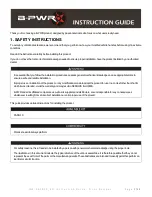
APPENDIX B. GLOSSARY
CALIBRATION CURVE
A graph of load versus output. Typically, it is a
straight line and relates live load to a voltage or
digital count output.
LIVE LOAD
The weight of the material to be measured;
in other words, the weight of the contents of the
vessel.
HYSTERESIS
The maximum difference between sensor
readings for the same applied load, with one
reading obtained by increasing the load from zero
and the other reading obtained by decreasing the
load from the rated load. It is usually expressed
as a percentage of the rated load.
NON-LINEARITY
The maximum deviation of the sensor calibration
curve from a straight line between zero load and
the rated load.
REPEATABILITY
The maximum difference between sensor readings
for repeated loadings under identical loading and
environmental conditions.
SENSITIVITY
The ratio of the change in electrical output to the
change in load or stress.
SIGNAL PROCESSOR
The electronic firmware and software box
connected to a sensor (such as a Microcell™) or
transducer array. If it is augmented with software,
the first stage of the signal processor is an A/D
converter. A signal processor generally has
provisions for most, if not all, of the following:
1. Excitation voltage applies to each of the
sensors/transducers in the network.
2. Adjustable zero calibration.
3. Adjustable scale factor.
4. Long-distance signal transmission options,
such as 4-20mA or serial transmission.
5. Set Point (commonly referred to as a contact
closure) to provide a discrete indication that a
specific point has been reached.
6. Some type of indicator or display, such as
numerals, needle movement, discrete LED
array, etc.
34
Summary of Contents for Microcell
Page 20: ...Figure 3 18 Cutting Wrap Width Figure 3 19 Installing Brace Wrap 16 ...
Page 22: ...Figure 4 2 Microcell Mounting Locations 18 ...
Page 30: ...Figure 4 16 Wiring Junction Boxes Together Non Conduited Installation 26 ...
Page 37: ...33 ...
Page 42: ...38 ...
Page 43: ......






































